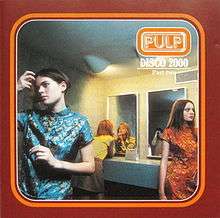Disco 2000 (song)
| "Disco 2000" | |||||||
|---|---|---|---|---|---|---|---|
 vinyl single, CD single (part one) | |||||||
| Single by Pulp | |||||||
| from the album Different Class | |||||||
| B-side | "Ansaphone" | ||||||
| Released | 27 November 1995 | ||||||
| Format | |||||||
| Genre | |||||||
| Length |
4:33 (album version) 4:51 (7" mix) | ||||||
| Label | Island | ||||||
| Writer(s) | Jarvis Cocker, Nick Banks, Steve Mackey, Russell Senior, Candida Doyle and Mark Webber | ||||||
| Producer(s) | Alan Tarney (single, 7" remix), Chris Thomas (album version) | ||||||
| Pulp singles chronology | |||||||
| |||||||
| |||||||
"Disco 2000" is a hit single by British band Pulp, released in 1995. It reached No. 7 in the UK Singles Chart.[1] It was the third single from the album Different Class, following "Common People" and the double A-side "Mis-Shapes"/"Sorted for E's & Wizz", both of which reached No. 2.
The song tells the story of a narrator falling for a childhood friend called Deborah, who is more popular than he is and wondering what it would be like to meet again when they are older. The song is based on true events. Pulp frontman Jarvis Cocker said "the only bit that isn't true is the woodchip wallpaper."[2]
Deborah was based on a real life childhood friend of Cocker's, Deborah Bone, who moved away from Sheffield to Letchworth when she was 10. As the lyrics suggest, she did marry and have children.[3]
It is believed that the fountain referred to as the meeting place was Goodwin Fountain, formerly located on Fargate, in Sheffield city centre. The song's riff is said to be influenced by Laura Branigan's 1980s hit "Gloria".[4]
Due to its millennial subject matter, Pulp removed the song's synchronisation licence, effectively banning the song from being used in TV and radio trailers throughout 1999 and 2000.[5]
Track listing
CD
All lyrics written by Jarvis Cocker; all music composed by Jarvis Cocker, Nick Banks, Steve Mackey, Russell Senior, Candida Doyle and Mark Webber.
| Part one | ||
|---|---|---|
| No. | Title | Length |
| 1. | "Disco 2000" (7" mix) | 4:51 |
| 2. | "Disco 2000" (album mix) | 4:33 |
| 3. | "Ansaphone" | 4:01 |
| 4. | "Live Bed Show" (extended) | 4:10 |
| Part two | ||
|---|---|---|
| No. | Title | Length |
| 1. | "Disco 2000" (album mix) | 4:33 |
| 2. | "Disco 2000" (7" mix) | 4:51 |
| 3. | "Disco 2000" (Motiv 8 Discoid Mix) | 7:31 |
| 4. | "Disco 2000" (Motiv 8 Gimp Dub) | 6:31 |
| Single-CD version | ||
|---|---|---|
| No. | Title | Length |
| 1. | "Disco 2000" (7" mix) | 4:51 |
| 2. | "Disco 2000" (Motiv 8 Discoid Mix) | 7:31 |
- UK Cassette editions have the same track listing.
12"
| Side A | ||
|---|---|---|
| No. | Title | Length |
| 1. | "Disco 2000" (7" mix) | 4:51 |
| 2. | "Ansaphone" | 4:01 |
| Side B | ||
|---|---|---|
| No. | Title | Length |
| 3. | "Disco 2000" (Motiv 8 Discoid Mix) | 7:31 |
| 4. | "Disco 2000" (Motiv 8 Gimp Dub) | 6:31 |
7"
| Orange vinyl | ||
|---|---|---|
| No. | Title | Length |
| 1. | "Disco 2000" (7" mix) | 4:51 |
| 2. | "Ansaphone" | 4:01 |
- Released: November 1996.
In popular culture
"Disco 2000" was featured in Episode 7 of the first series of Life on Mars, where DI Sam Tyler hears it come on the radio in 1973, and mentions to DCI Gene Hunt that he had seen Pulp play the Manchester Nynex in 1996, to Hunt's bemusement. The song also appeared in a party scene in the 2013 Seth Rogen film This Is the End, and again in the "The End of the Tour" in 2015.
In 1996, it featured on the UEFA Euro 1996 official album, The Beautiful Game.
In September 2015, the song featured in an advert for airline company easyJet to mark the company's 20th anniversary.
Cover versions
The song was covered by Nick Cave as a b-side for the single "Bad Cover Version".
Personnel
- Jarvis Cocker: Vocals
- Russell Senior: Guitar
- Mark Webber: Guitar
- Candida Doyle: Keyboards
- Steve Mackey: Bass guitar
- Nick Banks: Drums
References
- ↑ "Chartstats – Pulp – Disco 2000". Retrieved 2010-02-07.
- ↑ Interview with Jarvis Cocker, Liz Kershaw, BBC 6Music, 22 November 2002 Transcript
- ↑ Vincent, Alex (2 January 2015). "Deborah Bone, who inspired Pulp's Disco 2000, dies aged 51". The Daily Telegraph. Retrieved 2 January 2015.
- ↑ Allmusic review
- ↑ News, Select. January 1999.
